This is the text of a paper given by Stephanie at the Occulture Esoteric Conference, Berlin, November 17/18 2018, which traces the Damballah double snake of virtual reality’s twin ancestry in Paganism and Vodun, through its coding and its rituals.
Coding the Digital Occult:
The Binary [Techno]Pagan and Vodun Ontologies of Cyberspace
Stephanie gave this paper at the Occulture Esoteric Conference in Berlin on 17/18 November.
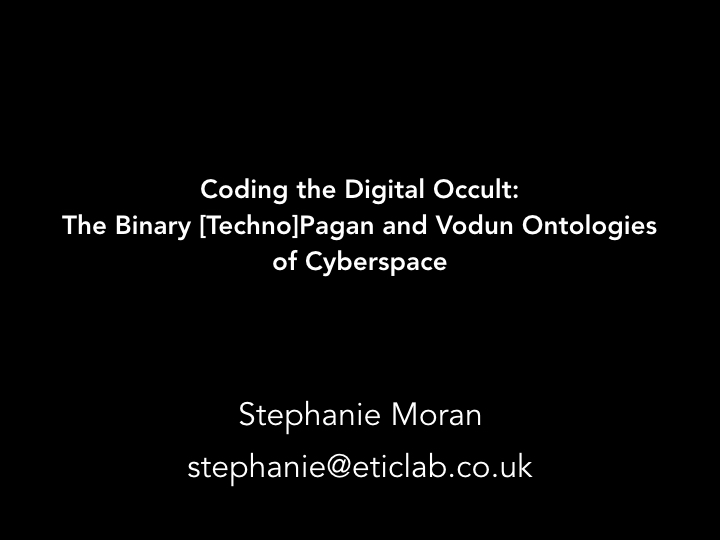
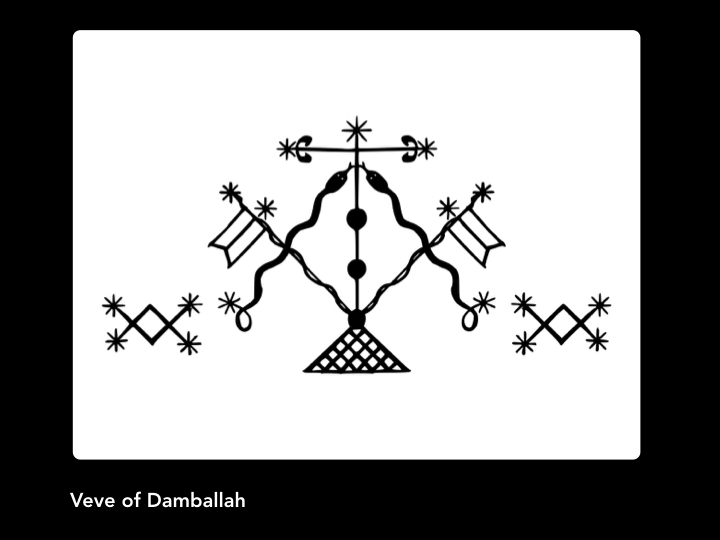
This paper will be tracing the Damballah double snake of virtual reality’s twin ancestry in Paganism and Vodun, through its coding and its rituals. This doubling is inherent to cyberspace’s binary DNA. Virtual reality was mystically conceived in mathematician Vernor Vinge’s sci-fi writings, and, famously, inhabited by the vodou loa in William Gibson’s Count Zero; however its genealogy goes back to origins in West African Vodun that precede Western computation, Leibniz’s binary code and geomancy by centuries perhaps.
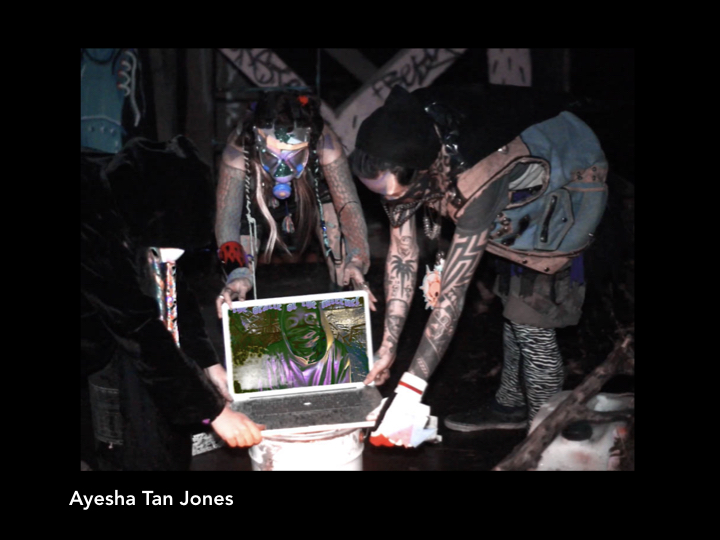
The term Technopagan, as coined by Erik Davis (1995), designates a range of practices: “goddess-worshippers, ceremonial magicians, witches, Radical Fairies” that were floating around the internet back then, and which have been resurfacing of late in new forms, in pockets of subcultural online communities. If Davis’ 90s technopaganism was largely US-based and made up of “almost exclusively white folks drawn from bohemian and middle-class enclaves”, its current, much more culturally diverse iteration, expresses a heritage that can be traced back to pre-colonial West African Vodun coding practices.
It will take an entwined binary approach, looking at Mark Pesce’s ‘technopaganism’ and his development of virtual reality coding (VRML). It will investigate technopagan and occult concepts of cyberspace, and the way this is structured through its VRML code, psychic architectures, hermetic glyphs, idea spaces, sigils, and rituals performed on the virtual astral plane. These had their beginning in Pesce’s 1994 Cybersamhain ritual to inaugurate cyberspace, and continued through the obscure Cybernetic Cultures Research Unit in the late-90s and early 2000s.
It will examine the origins of cyberspace’s coded ontologies, in both its digital and its analogue structures, from VRML to neural net computation and nonlinear phase-space, in African Vodun’s divination practices, doubling, base-2 calculation, geometric algorithms, and ritual drum pattern communication systems with the dead. This paper will move through time in a nonlinear fashion, connecting nodal points of an occult internet history, of ‘cyberspace’.
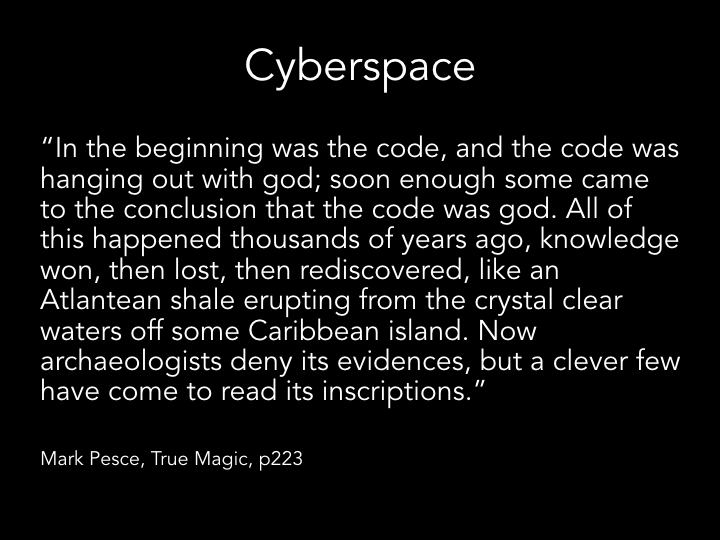
Mark Pesce and ‘Cyberspace’
When I talk about cyberspace, I’m using it very specifically in the sense that Pesce uses it, the 90s cyberculture sense – in relation to virtual reality; the idea of creating, or rediscovering, a multi-dimensional world through code:
“In the beginning was the code, and the code was hanging out with god; soon enough some came to the conclusion that the code was god. All of this happened thousands of years ago, knowledge won, then lost, then rediscovered, like an Atlantean shale erupting from the crystal clear waters off some Caribbean island. Now archaeologists deny its evidences, but a clever few have come to read its inscriptions.” (Pesce, 2001. p223)
There is at least a symbolic truth here that Pesce is pointing to: a genealogy, occult mythology, and ontology for a new world, for those who understand the code. To break this down, his symbolic references position code as god / god as code, with code replacing the word, or logos, in shaping this new world. There is a reference to the lost island-civilisation of Atlantis, endowing the new world with a mythological pre-history. He also references the Caribbean, the birthplace of the hybrid form of Vodou that William Gibson populated cyberspace with. The crystal of the Caribbean ocean prefigures his linking of the use of liquid crystal in our screens with esoteric crystal technologies, from the art of scrying to the lost technologies of Atlantis, and the capacities the internet gives us to view things on the other side of this world and to act remotely. Pesce has cited the three authors who defined cyberspace as Vernor Vinge (True Names, 1978), William Gibson (Neuromancer, 1984, Count Zero, 1986, Mona Lisa Overdrive, 1988), and Neal Stephenson (Snow Crash, 1992), and was clear about his intention to create a new, parallel universe of infinite possibility constructed from code (Aupers, 2009; p159).
Revisiting the late 90s: Technopagans and Virtual Reality
In his 1995 Wired article, Technopagans, and his 1997 book, Techgnosis, Erik Davis named and described a growing online phenomenon he had researched as an ‘observing participant’. The 90s and early 2000s saw a minor spate of publication related to technopagan practice, from books about cyberculture such as those by Davis and Mark Dery, to manuals for online magickal practice (Davis, 1997; Dery, 1996).
[The Cyberspell book: Magick in the Virtual World (Knight and Telesco, 2002), The Virtual Pagan: Exploring Wicca and Paganism through the Internet (2002, McSherry), Witchcraft and the Web: Weaving Pagan Traditions Online (Nightmare, 2001), and Penczak’s City Magick. Urban Rituals, Spells, and Shaman- ism (2001)…]
In Stef Aupers’ survey, as he states in Revenge of the Machines:
“A qualitative analysis of Wired Magazine (1993-2000) shows that various computer specialists, who are ‘supposed’ to be the pioneers of a rational, secular and disenchanted society, can be seen as ‘technoanimists’. They consider our new technological surroundings as an intelligent, autonomous force and express feelings of humility. Exemplary for this phenomenon is a group of ICT-experts who refer to themselves as ‘technopagans’.”
(Aupers, 2001; p)
One of these silicon valley tech people was Mark Pesce. He told Aupers in a 2001 interview:
“I went to San Francisco and started working in Virtual Reality… thinking about Virtual Reality and now starting to work in it as a programmer and designer and trying to create it, I now start to see correlations between what we would call “magical thinking” and what we would think of it as the designer: the ontology of cyberspace (..) And it starts changing the way I think the world is constructed. This starts to have an influence on my technical practice. It starts to feedback on my ontological understanding of the world. And that just became a feedback. Until I ended in this place which you can call technopaganism.” (Aupers, 2009. P159-160).
Ontologies
This reference to ontology, and its dual meanings, provides the hinge between coding, cyberspace or virtuality, and magic. Ontology as a philosophical concept about the nature of being – what it means to exist, what kind of things exist; and as a branch of metaphysics; it is also a term in information technology and computing, used to refer to a set of concepts and categories in a subject area that shows their properties and the relations between them, or very simply, sorting things into kinds – which can be a way of creating / organizing a system of knowledge. All of which connect to the nature of magick – you could think of magick as both a metaphysics and an immanent, or embodied, way of structuring a system of knowledge, through ritual / practice.
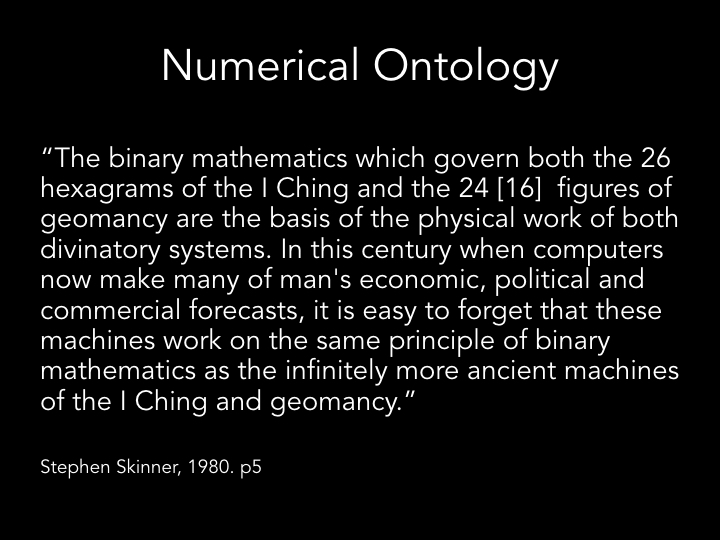
Numerical Ontology
The deep ontology of cyberspace is mathematical. As technopagan programmers interviewed by Stef Aupers in 2001 say:
“[Jennifer:] There are levels in computers that most people have never seen.” Others, such as Lorry Wood, point out the mystery of the zeroes and the ones that meet each other in the deeper layers of the computer” (Aupers, 2009. p161)
Where do these zeroes and ones come from? Leibniz invented the modern binary code system, but his idea didn’t appear out of nothing. Binary mathematics already existed, in immanent forms. Leibniz became aware of the binary system through both the I-Ching and through Ramon Llull’s logic machines. He saw a new application for it, and theorized it through Western mathematical forms (Eglash, 1999. p100).
Stephen Skinner suggests that African geomantic divination came from the Arabic divination system ilm al-raml, the ‘science of sand’, but Ron Eglash’s research and his work in Ethnomathematics makes a convincing case for it originating the other way round, as African thought possessed a long tradition of binaries, while base 2 calculation was alien to Arabic, Greek and Kabbalistic systems (Skinner, 1980; Eglash, 1999).
Ethnomathematics, or mathematical anthropology, looks at the “mathematical modeling of social and material cultures”. It examines immanent mathematical thought in non-Western cultures, and can help trace the development of thought through this immanent mathematics similarly to the ways in which linguists can speculate on probable lineages of ideas. As Eglash says:
“Mathematically… geomancy is strikingly out of place in Non-African systems. Like other linguistic codes, number bases tend to have an extremely long historical persistence.” (Eglash, 1999, p99)
As we will see, doubling is an important theme in African culture and religious practice, particularly in the divinatory practices, mythologies and metaphysics of Vodun and its connected religions (Eglash 1999. pp89-93).
Analogue representation: Iterative Looping, Neural Nets and Nonlinear Phase Space
Divination was incorporated into Dahomean Vodun from Yoruba Fa divination (Rush, 2013) There are related variations of divinatory practice across West Africa, some use set verses like the I Ching in the interpretation, but essentially they all operate similarly. Ron Eglash discusses Bamana sand divination’s long tradition of iterative looping to generate sets of binaries. Iterative looping is used in maths and cybernetics, it means passing outputs of an operation back as inputs, in a reflexive process.
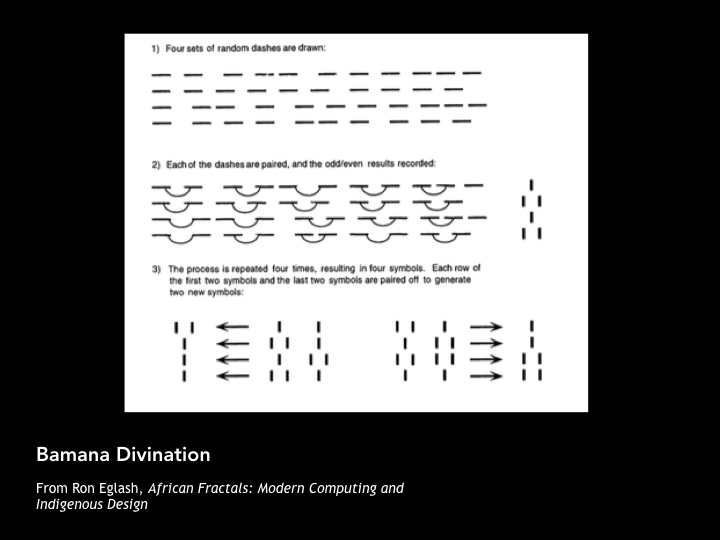
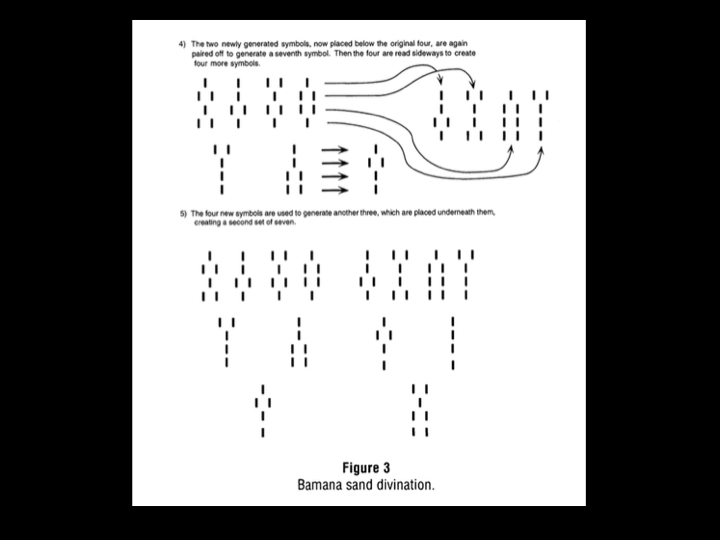
In Bamana divination, binaries are created by drawing four sets of random dashes in the sand, pairing them, and recording odd and even results to generate a symbol. This process is repeated four times. The resulting symbols are each paired to generate two more symbols.
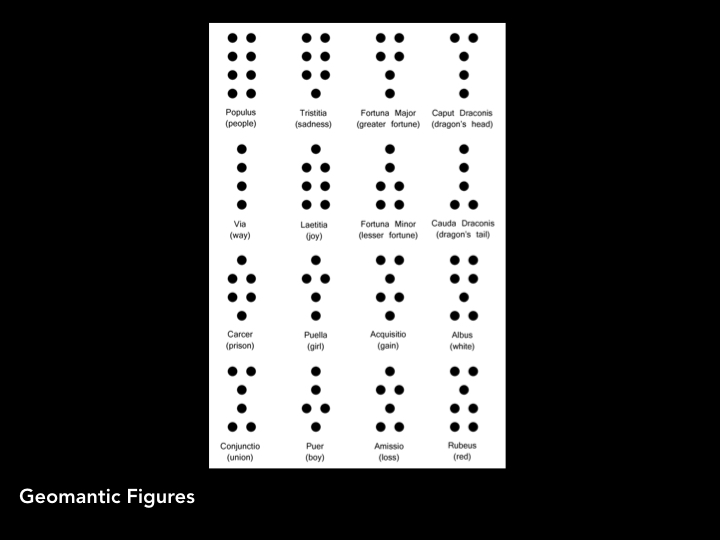
Some of you may recognize this structure, the 16 possible permutations being equivalent to the 16 geomantic figures, each of which – in both traditions – represent a particular thing (such as travel, or desire). In Bamana divination each symbol’s meaning is also assigned a position, or ‘house’, where it belongs; the symbols and their positions in the divination are read in relation to each other [eg. Desire in the house of travel = desire to travel]. This process codes self-generated variety through binaries. Eglash describes it as a similar system in principle to Marston Morse’s nonlinear dynamics ‘chaos’ model for self-generated variety. (Eglash, 1999; p97)
While European versions of geomancy replaced systemic determinism with chance (culturally, Europeans couldn’t accept the idea of random results coming from determined systems), African divination embraces the anti-intuitive pairing of determinism and unpredictability. Eglash connects this to African cosmology, particularly in the form of the ‘trickster’ god, which is explicit in the mythology of Legba’s inverted logic system.
The trickster god has many variations on his name, as he moves between the Yoruba, Fon, Mina and Ewe-speaking peoples of Africa, and his diasporic identities in Haiti, Cuba, Puerto Rico. He is known as Legba [Ewe-Fon] [Yoruba] Eshu-Elegba / Eshu / Elegbara / Elleggua / Papa Legba (Rush, 2013. p76). He is a god of mischief, as well as a protector and the guardian and keeper of crossroads, controller of communication between worlds:
“Legba is the great communicator, but also the great miscommunicator. He is fond of riddles, paradox and ambiguity. He allows us to speak with the gods, but he also plays tricks with their messages.” (Filan, 2006. p74)
In Fa divination mythology, Legba is responsible for opening either one or two of the god Fa’s sixteen eyes (equivalent to the sixteen divinatory figures). Fa would put palm nuts into Legba’s hand to indicate how many eyes to open, but, knowing Legba’s mischievous and contradictory ways, he would take care to put one nut for two eyes and two for one eye. (Skinner, 1980. p56)
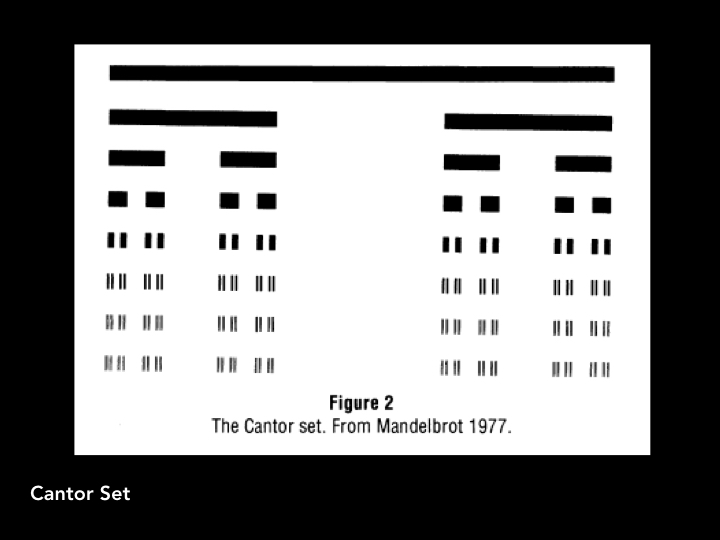
The final divinatory diagram has a visual similarity to the Cantor set. The Cantor set is a recursively constructed set; it proved that between zero and one there are a more-than-infinite number of points, and became the basis for computational modelling of natural self-organising systems. “[Computational] neural nets are distributed systems which function as analogues of the brain and can learn, think, ‘evolve’ and ‘live’.” (Plant, 2000, p). When a system self-generates variety, there is the potential for learning, thinking and evolving. In a Legba-style transposition, Eglash also notes an inverse symmetry between the models – where Cantor’s set showed a more-than-infinity contained within one, the Bamana reductively code the more-than-infinite possibility of the future down to one reading (prediction). (Eglash, 1999)
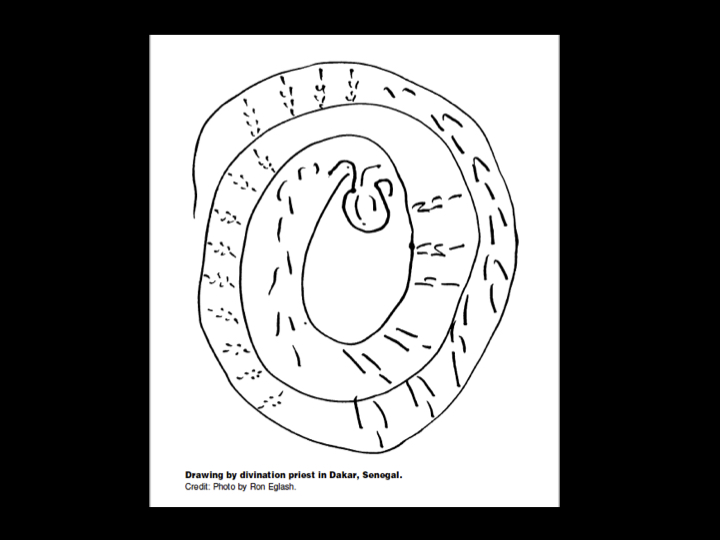
West African divinatory spiral waveform symbols represent life force, often diagrammed in relation to the transference of the life force in sacrificial offerings; in Vodun, this is connected to communication, and particular drum patterns used in vodun rituals – the off-beat phrasing of African music, which visually and rhythmically represent geometric algorithmic structures – are a technology for communication with the dead. This is also an example of a recursive analogue system, which have an equivalent in Western mathematics: “In European mathematical physics these are know as Chladni patterns, and they have been an important source for the development of theories of waves and vibrations.” (Eglash & Bleecker, 2001. p358-360)
The Cantor set, and the divinatory diagram, prefigure the concept of ‘phase space’: “In dynamical system theory, a phase space is a space in which all possible states of a system are represented, with each possible state corresponding to one unique point in the phase space” [Wikipedia]. Binary zeros and ones make up the substrate of cyberspace, the substrate of digital computing, while the space between the ones and zeroes contain self-organising systems of infinite possibility: “the one and zero states of digital circuitry… exclude an unpredictable, dynamic middle, a narrow band of intense, nonlinear activity” (Mark Pesce, 2001. p225).
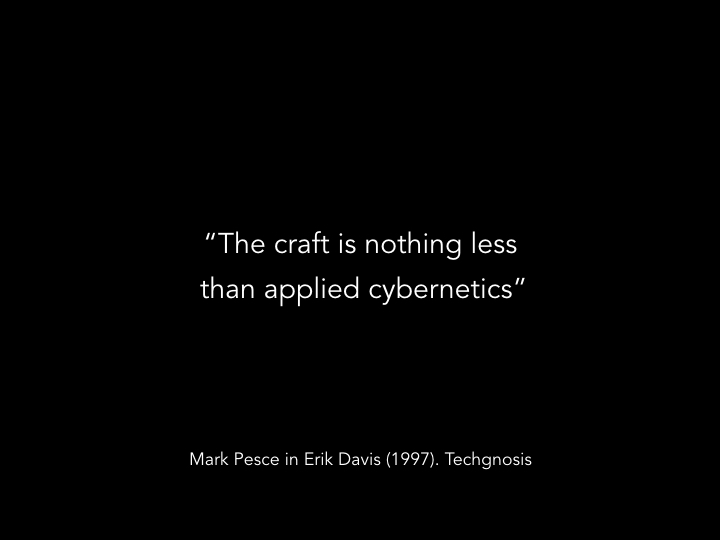
VRML
The VRML language that Pesce invented in the mid-90s, sat on top of the binary code layer, and below the graphical user interface (GUI), as an intermediary translator that interfaced with the html script. VRML, like all computer programmes, conveyed instructions, while binary code carried them out; computer wizards wrote the commands, while the GUI allowed non-initiates to interface with the systems. VRML was a scene description language, not a programming language. It was a text-based computer language, a digital incantation that created static scenes. According to Pesce, “the essence of VR is communication and experience, not reality and immersion” (Pesce, 1995. p31).
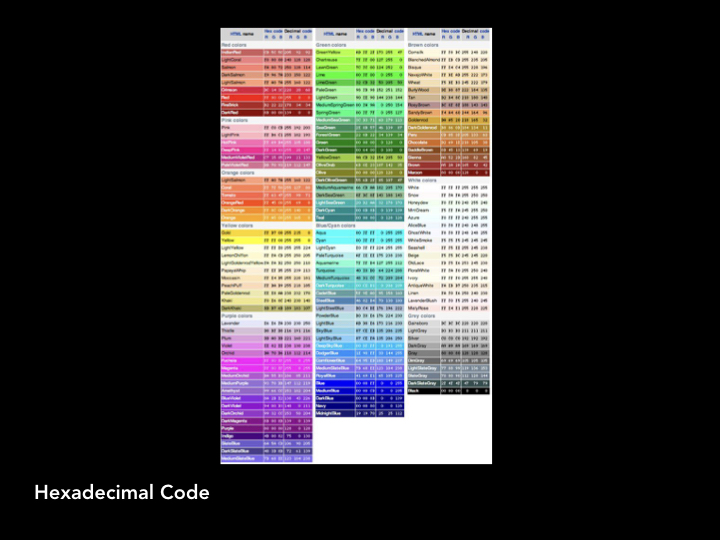
Pesce’s VRML manual was itself structured like a pagan ritual, with the four parts each dedicated to East, South, West and North, and various pathways through it [novice / hacker / designer]. The design of cyberspace is along the lines of the ‘physics’ (or rather, metaphysics) of astral or sacred space:
“[Pesce] is convinced that after a period of three centuries of rational, technical and analytical thinking, we are re-entering an age of magic. According to Pesce… our rapidly emerging digital environment can only be captured by ancient magical concepts. Technological and magical ontologies thus converge in his worldview.” (Aupers, 2009. p159)
Pesce’s view was echoed by a number of interviewed participants in Aupers’ 2001 fieldwork study. Pesce himself asserts that nearly all of the early Silicon Valley cyberspace coders adopted a pagan religious view towards cyberspace / virtuality: “a religious philosophy of immanence – that the divine is present in all creation, but in manifold forms” (Pesce, 2001. p232).
VRML, like many computer programmes, utilised hexadecimal coding (often referred to as hex coding) for colour description. Etymologically, I haven’t yet found an explicit link between hex as in a spell – derived from the German hexen for witch – and the number six from the Greek, but I assume the occult symbol of the six-sided hexagram provides the connection. Hex coding operates on a base-16 system, it uses sixteen distinct symbols broken into 10 + 6. Each hexadecimal digit represents four binary digits. [slide 13.] This structure echoes the 16 figures of geomancy, and their four-bit binary composition / construction, as well as the Chinese hexadecimal system and its relationship to the I Ching. Ethnomathematically, the relationships between occult mathematically-based symbols such as the hexagram, or systems such as geomancy or the I-Ching, and their respective incantations, could be viewed as precursors to computational programming structures.
In cyberspace, Pesce says, every object is made up of pixels that everyone interacting in the simulation agrees to treat as the object; therefore, he says, “every object in cyberspace is a magical object” (Pesce, 2001. p230).
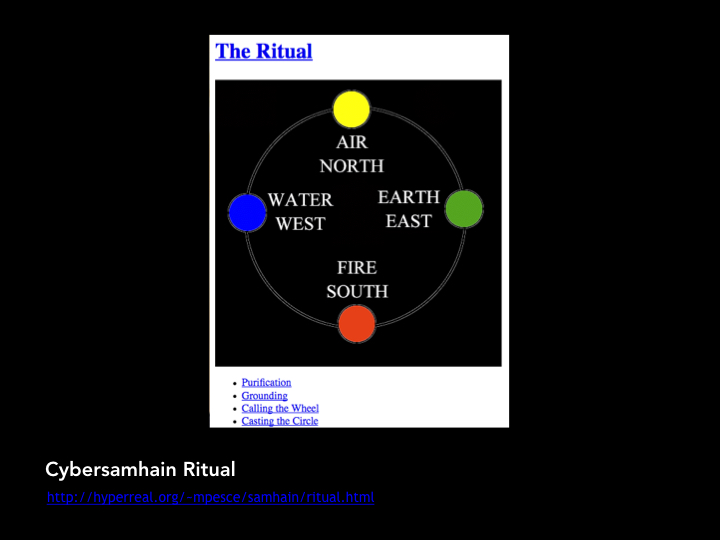
This excerpt from the introduction to Pesce’s Cybersamhain ritual in 1997 makes overt the connection between occult geometries and cybernetic form:
“from the creation stories told around the campfire through the sacred geometries revealed in our cybernetic understanding of form, the sacred is imminent, accessible, and necessary… magick is our technos developed to manipulate world-view, or rather perception of the world, and hence, reality.”
[For full cybersamhain ritual see: http://hyperreal.org/~mpesce/samhain/ritual.html]
The Psychic Architectures of Cyberspace
Mark Pesce overtly links his technical practice to inspiration from sci-fi and cyberpunk [a subgenre of sci-fi, every tech nerd’s dream: depicting hacker culture in highly advanced technoculture futures, generally against backdrops of vastly unequal access to tech and rapid technological and social change]. In William Gibson’s cyberpunk Sprawl trilogy, Vodou entities manifest through computer code. The Vodou loa, or gods, are stalking cyberspace; or, more accurately, cyberspace has been appropriated by Vodou as a vector for its operations. As one of the characters says, he doesn’t care if it’s a religion, Vodou is a structure, a system:
“it isn’t concerned with notions of salvation and transcendence. What it’s about is getting things done.” (Gibson, 1986. p76) [its role in the novel]. Gibson’s reading of Vodou is echoed by Dana Rush’s formulation based on extensive field research in Benin:
“Vodun and its spirits defy conventional categorization. Vodun does not formulate fundamental principles by which it acts; rather, it prioritises action. Instead of abiding by philosophical tenets and devising or following doctrine like most religions, Vodun’s focus is on making things happen and getting things done… [which] thrusts Vodun art and aesthetics into everything from problem solving and conflict resolution to protection and healing.” [there is no sacred text, but constant contingent action and revision] (Rush, 2013. p3)
Vodou originated in West African Vodun, and crossed to the New World with the Middle Passage. Forms of Vodun are practiced across West coastal Africa. Most of the (not vast) literature on African Vodun centres around Benin (where the former kingdom of Dahomey was located) and Togo (eg. Suzanne P Blier, Dana Rush, G. Parrinder). The Fon of Dahomey and the Yoruba of Nigeria share very similar religious practice but with different names; vodun is Dahomean, while the Yoruba use the term orisha.
As we will see, Gibson’s version of Vodou has been gathered up into the occult mythology of cyberspace; but also, Vodun practice and mythology is immanent to some of cyberspace’s key founding concepts and deep systems, particularly in the loa Legba and Damballah.
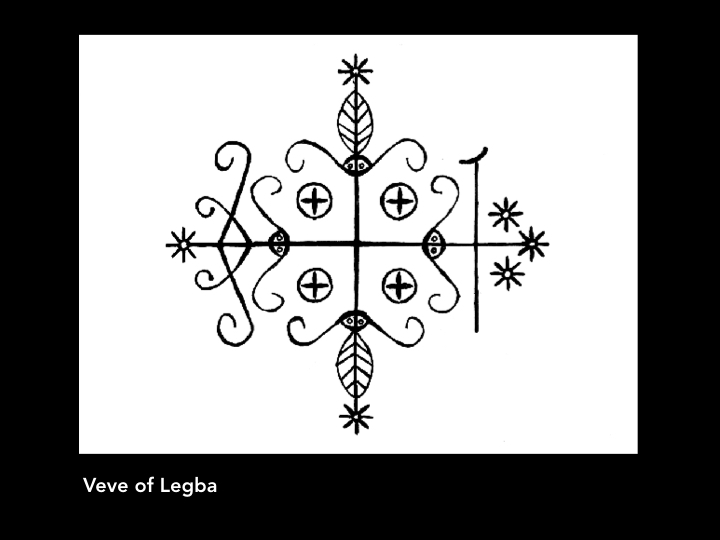
In Gibson’s Count Zero, the loa Legba guards the entrance to cyberspace. Legba, the god of the crossroads, is symbolic of the place where heaven and earth meet, and communication between the spirit and human worlds: “For tribal Africans, the cross did not represent the crucifixion, but the creation of the universe. When the Godhead created the world, she moved to the four corners of the universe, thereby creating a cross.” (Filan, 2006. p73-74)

The Vodun operating system functions through ritual practice, based on a myth structure. Each loa has a veve, or magical symbol or sigil, which also serve as a means of communication.
Possession trances occur on successful contact with the loa, and the particular loa contacted is said to ride the possessed. In the final book of the trilogy, Mona Lisa Overdrive, Angie has a veve written on her brain and the loa can interface with her directly. In Count Zero, however, the loa Danbala rides hackers when they connect to the net:
“Think of Jackie as a deck, Bobby, a cyberspace deck… Think of Danbala, who some people call the snake, as a program. Say as an icebreaker. Danbala slots into the Jackie’s deck, Jackie cuts ice. That’s all.”
Damballah / Danbala / Damballah Wedo is the serpent loa, the white python god, source of life; his veve is commonly depicted with two snakes – Damballah and his female partner snake, Ayida Wedo. Damballah Aida Wedo coils together like the DNA double helix, reflecting the binary structure of life’s beginnings.
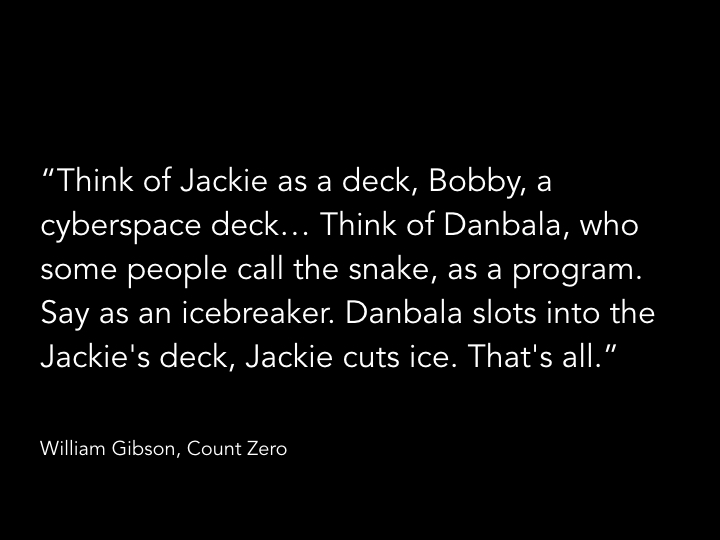
Idea Spaces, Patchwork Rituals and Hermetic Glyphs
And cyberspace began with Vernor Vinge’s multi-dimensional astral plane framework, called the ‘Other Plane’, a dataspace enabled through EEG inputs and outputs, whose operators are warlocks. Pesce states that Vinge “laid down the operating laws for the first quarter-century of research into virtuality” (Pesce, 2001. p228). The space of virtuality was empty, an “interior emptiness” or psychic architecture waiting to be populated with simulations.
In the CCRU’s occult hyperstition, a web of distributed online fictions that aimed to prefigure the future (a philosophical concept coined by Nick Land / CCRU in the late 90s – something that is more than a superstition, that prefigures and ushers in the futures, and is related to technological acceleration and particularly economic algorithmic acceleration of high-frequency trading) cyberspace is imagined as a ‘black mirror’ (CCRU, 1998/2015). A post-Gibsonian imaginary precursor of the dark web perhaps:
“Cybergothic exists as a web of sinister rumour, haunting a subterranean soft-labyrinth which it calls ‘the Crypt’. Buried deep within the primal sediment of the infoplex, and shrouded in a crawling fog of digital camouflage, it isn’t easy to find, but there are clues… [it is] the dark twin of the net – where Gibsonian ‘flatlining’ is rapidly transmuting from exotic fiction into pop-cult and mass-transit system.
“’You could describe it as the route to contemporary shamanism’.” (CCRU, 2015. p229) CCRU produced a pick&mix cyberhorror, blending Gibson, Vinge, Lovecraft, Kantian time, and voodoo. They developed veve-like glyphs to summon the five pentazygonic demons of the occult Lemurian race, from the lost continent of Lemuria, in a kind of cut-and-paste, patchwork occult system.
The construction of spatialised information whether on the astral plane or in cyberspace allows for creation of a ritual space (although, in the 90s this was largely invoked through lines of text in the [text-based] MUDs, MOOs and chatrooms, along with the very basic graphics of the early web, and pasted pictures).
The resurgence of an oral-visual culture (like those of paganism and Vodun) via technology was conceptualised by Walter Ong in the 1980s (Ong, 1982), and the current configuration of the technologically-produced sensorium is even more visual, but it also moves ever algorithmically faster, in less humanly-understandable ways. A technopagan called Reason suggests:
“The future will look very much like the way our ancestors thought their world looked like (..) Artificial Intelligences: those will be our spirits. Because once we’ve built them, they will be too complex for us to understand. And you will deal with an Artificial Intelligence, the same way you deal with a spirit. You make bargains. You talk to it. Try to understand it. But it will always have that greater advantage over you.” (Aupers, 2009. p163)
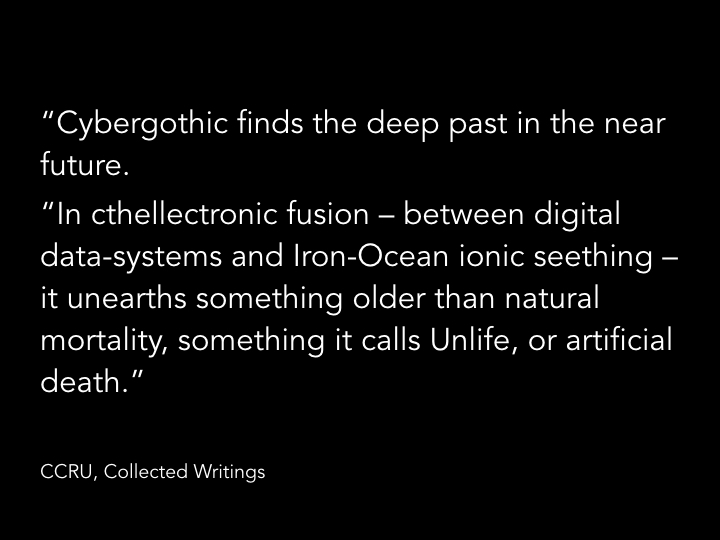
You can now read Coding the Digital Occult Part II: Semiotic-Poetic Vectors here.
Bibliography
Aupers, S. (2009) Force is Great
Aupers, S. (2001) Revenge of the Machines
Beth, David (2008). Voudon Gnosis
CCRU (2015). CCRU Writings 1997-2003
Davis, E. (1995) Technopagans
Davis, E. (1997) Techgnosis
Dery, M. (1996). Escape Velocity: Cyberculture at the End of the Century
Eglash, R. (1999). African Fractals: Modern Computing and Indigenous Design
Eglash, R. (1997). Bamana Sand Divination: Recursion in Ethnomathematics
Eglash, R. & Bleecker, J. (2001). The Race for Cyberspace: Information Technology in the Black Diaspora
Filan, K. (2006). The Haitian Vodou Handbook: Protocols for Riding with the Loa
Fondation Cartier (2011). Vodun: African Voodoo
Gibson, W. (1984) Neuromancer
Gibson, W. (1986) Count Zero
Gibson, W. (1988) Mona Lisa Overdrive
Ong, W. (1982) Orality and Literacy: The Technologizing of the Word
Plant, S. (2000). On the Matrix: Cyberfeminist Simulations
Pesce, M. (2001) ‘True Magic’. True Names and the Opening of the Cyberspace Frontier. Frenkel, J. (ed.)
Pesce, M. (1995). VRML: Browsing and Building Cyberspace
Rush, D. (2013). Vodun in Coastal Benin: Unfinished, Open-Ended, Global
Skinner, S. (1980). Terrestrial Astrology: Divination by Geomancy
Stephenson, N. (1992). Snow Crash
Vinge, V. (1978) True Names


